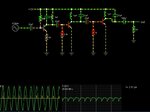RMMK
Full Member level 3
Thanks a lot.......... and really sorry for disturbing you when you yourself are busy in your project! I will build the circuit and come back with the results soon!
Follow along with the video below to see how to install our site as a web app on your home screen.
Note: This feature may not be available in some browsers.


1. generally, as you add more elements the impedance at the center feed point of the dipole increases. The amount it increases gets smaller as each new element is added so the ones nearest the dipole have most effect. The trick is to reduce the imedance by 'folding' the dipole. You will see it used on almost all TV/VHF antennas where the dipole is like a squashed loop. The length from end to end of the dipole is still the same but the far ends are joined to form a continuous length of conductor. Note that doing this makes the dipole look like a short circuit to DC so be careful to ensure there is a capacitor in series with it somewhere to prevent it shorting your power rails.
The impedance you use isn't particularly important as long as you match the transmitter to the antenna but the cable you use to join them has to be matched as well. This is why 75 Ohms is commonly used. There is nothing magic about 75 Ohms but a standard somewhere in that region had to be set so that cable manufacturers could make compatible products. You would normally make the transmitter output impedance 75 Ohms and use a 75 Ohm coaxial cable to connect it to 75 Ohm antenna..................
Brian.
Oops! sorry - I don't have access to all my data books and manuals at the moment, everything is in storage units while I move house. I'm working from memory which is obviously not as sharp as it used to be!
Regardless, the main problem RMMK will have is connecting the transmitter to the Yagi which at 27MHz is going to be quite large. It's the connecting cable that will cause the problem and need to be matched at both ends.
The folded dipole resistance is 648ohms........ But i am not sure what will be the feed point impedance when this dipole gets incorporated into the 4-element Yagi arrangement....... will it be 300ohms? Plz help....
but sir the parasitic elements will provide me more gain and a better front to back ratio of around 15db...... I was also provided with a solution in this thread for helix antenna and it was stated by Brian that in normal mode their size is smaller while in axial mode its comparable to its wavelength!
I was only able to find this calculator and its giving me horribly large value of length of wire!
https://www.daycounter.com/Calculators/Helical-Antenna-Design-Calculator.phtml
Also what would be the gain of folded dipole antenna only?
but sir the parasitic elements will provide me more gain and a better front to back ratio of around 15db...... I was also provided with a solution in this thread for helix antenna and it was stated by Brian that in normal mode their size is smaller while in axial mode its comparable to its wavelength!
I was only able to find this calculator and its giving me horribly large value of length of wire!
https://www.daycounter.com/Calculators/Helical-Antenna-Design-Calculator.phtml
Also what would be the gain of folded dipole antenna only?
But its working not much....... I dont know the gain if any it provides and is only providing me a pathetic range of 3-4m. This range really made me ditch it for the application i was thinking it to employ! Now side by side I am going to work on RF modules 433Mhz ones. I am thinking of placing the same modifications as above i.e., 4-element Yagi (it would be much smaller), the power amplifier on the transmitter (that cascaded arrangement with a power amplifier stage of 2N3866) and the preamplifier (that BF998 version i uploaded before) on receiver side. Of course I will change the values of the circuit to appropriate ones for 433MHz.
sir i was referring to directors and reflectors when i called for parasitic elements!
Ohhh and you don't need to call me sir .... thanks for the respect, but I have not been knighted by a king or queen
on a good designed and constructed circuit for 27 MHz, 0.5W and a 1 metre whip antenna you can easily get several km's around your local area
from a hilltop you would easily get 5 - 10 km's
A 2N3866 should give you ~ 1 - 2 Watts on 27 MHz ( ~ 0.5 W on 433 MHz).
Let me see if I can dig up any straight forward 27 MHz TX and RX circuits for you. A well designed and laid out RX circuit is just as important to be able to receive and amplify a weak signal